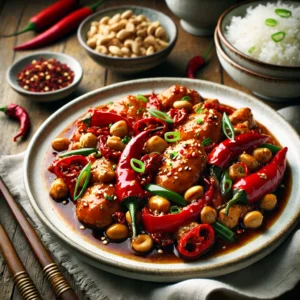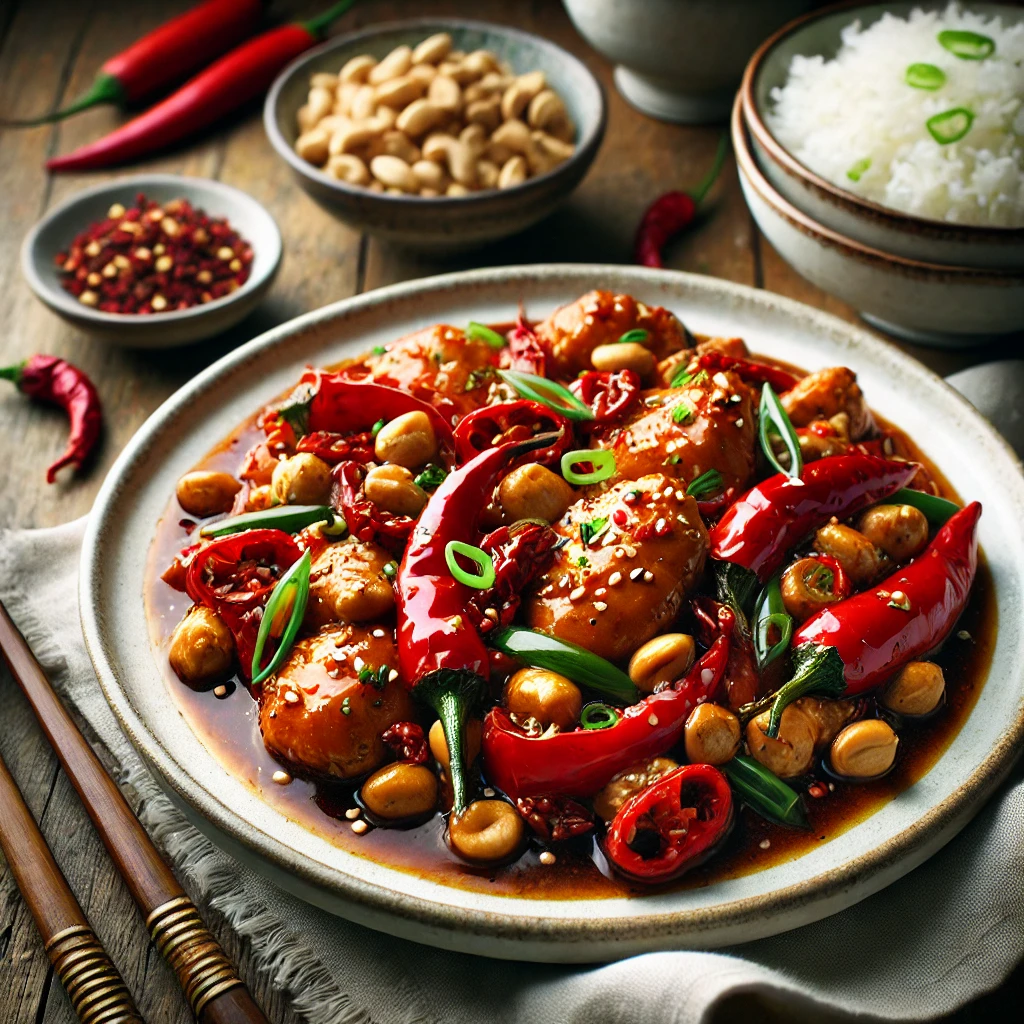Kung Pao Chicken is not just a dish; it’s a culinary experience that embodies the bold and complex flavors of Sichuan cuisine. Originating from China’s Sichuan province, this dish has gained immense popularity worldwide, and for good reason. Its delightful combination of savory, sweet, spicy, and nutty flavors makes it a standout choice for anyone looking to indulge in authentic Chinese cooking. Let’s delve into what makes this dish so special and explore the cultural, historical, and sensory elements that have cemented its place in the hearts of food lovers everywhere.

Kung Pao Chicken
Ingredients
For the chicken marinade
- 2 Chicken Breast boneless, skinless and diced (about 250g)
- 1 tbsp Soy Sauce
- 1 tsp Cornstarch
- 1 tsp Sesame Oil
For the sauce
- 2 tbsp Soy Sauce
- 1 tbsp Hoisin Sauce
- 1 tbsp Rice Vinegar
- 1 tbsp water
- 1 tsp Cornstarch
- 1 tbsp sugar
For the stir-fry
- 2 tbsp Vegetable Oil
- 4-6 Dried Red Chillies halved
- 1 tsp Sichuan Peppercorns
- 2 Garlic Clove minced
- 1 Bell Pepper Diced
- ½ cup Peanuts unsalted and roasted
- 2 Green Onions sliced
Instructions
- Marinate the Chicken: In a bowl, combine the diced chicken with soy sauce, cornstarch, and sesame oil. Let it marinate for 10 minutes while you prepare the other ingredients.
- Prepare the Sauce: In a small bowl, mix together soy sauce, hoisin sauce, rice vinegar, water, cornstarch, and sugar. Stir until the cornstarch is dissolved, then set aside.
- Stir-Fry the Chicken: Heat 1 tablespoon of vegetable oil in a large skillet or wok over medium-high heat. Add the marinated chicken and stir-fry until browned and cooked through, about 5 minutes. Remove the chicken from the pan and set aside.
- Cook the Aromatics: Add the remaining tablespoon of oil to the pan. Toss in the dried chilies and Sichuan peppercorns, stirring for about 30 seconds until fragrant. Add garlic and ginger, stir-frying for another 30 seconds.
- Add Vegetables and Peanuts: Stir in the bell pepper and cook for 2-3 minutes until it starts to soften. Add the cooked chicken and peanuts back into the pan.
- Combine and Serve: Pour the prepared sauce over the chicken and vegetables, stirring until the sauce thickens and coats everything evenly. Cook for another 2 minutes. Garnish with sliced green onions and serve hot with steamed rice.
A Rich History with Royal Origins
Kung Pao Chicken, known as “Gong Bao Ji Ding” in Mandarin, is said to be named after Ding Baozhen, a Qing Dynasty official who held the title of “Gong Bao” (Palace Guardian). The dish was reportedly created in his honor, as it was one of his favorite meals. Over time, it became a staple in Sichuan cuisine, celebrated for its fiery flavors and harmonious balance.
Interestingly, Kung Pao Chicken has undergone transformations as it spread beyond China. The version commonly found in Western Chinese restaurants is often milder and includes additional ingredients like vegetables, catering to a broader palate. Despite these adaptations, the dish’s essence remains intact, and its popularity continues to soar.
The Anatomy of Flavors
Kung Pao Chicken is a masterclass in flavor layering. At its core, the dish combines tender, bite-sized chicken pieces with roasted peanuts, dried red chilies, and a sauce that is the star of the show. The sauce typically includes soy sauce, vinegar, sugar, and Sichuan peppercorns, creating a symphony of taste sensations:
- Savory: The umami-rich soy sauce forms the backbone of the dish.
- Sweet: A hint of sugar balances the spice and tanginess.
- Spicy: Dried red chilies and, in authentic versions, Sichuan peppercorns bring a bold, numbing heat.
- Tangy: Rice vinegar adds a refreshing zing.
- Nutty: Roasted peanuts provide crunch and depth, complementing the sauce and chicken perfectly.
The interplay of these flavors ensures that every bite is a burst of excitement, keeping your taste buds engaged from start to finish.
The Art of Balance
What makes Kung Pao Chicken truly exceptional is its ability to balance contrasting flavors and textures. The heat of the chilies is offset by the sweetness of the sauce, while the crunch of the peanuts contrasts beautifully with the tender chicken. This balance is a hallmark of Sichuan cuisine, which prides itself on achieving harmony in every dish.
Even the preparation process reflects this commitment to balance. Each ingredient is carefully measured and cooked to ensure that no single flavor overpowers the others. The result is a dish that feels complete and satisfying, with each element contributing to the overall experience.
A Feast for the Senses
Kung Pao Chicken is as much a visual delight as it is a gastronomic one. The vibrant red of the dried chilies, the glossy sheen of the sauce, and the fresh green of the garnish create a striking presentation that’s impossible to resist. The aroma is equally enticing, with the toasty scent of peanuts mingling with the fragrant spices and tangy sauce.
When it comes to texture, the dish doesn’t disappoint. The chicken is tender and juicy, the peanuts are satisfyingly crunchy, and the vegetables (if included) add a refreshing crispness. Together, these elements create a multi-sensory dining experience that leaves a lasting impression.
Global Appeal and Variations
While Kung Pao Chicken remains deeply rooted in Chinese culinary traditions, its global journey has given rise to countless variations. In Western adaptations, ingredients like bell peppers, zucchini, and even cashews are often added, offering a milder and more approachable version of the dish. Vegetarian and vegan alternatives have also emerged, substituting tofu or plant-based proteins for chicken.
Despite these adaptations, the essence of Kung Pao Chicken—its bold flavors and balanced composition—remains a common thread. This versatility is a testament to the dish’s universal appeal and its ability to adapt while staying true to its roots.
Why It’s Perfect for Two
Kung Pao Chicken is an ideal choice for an intimate meal for two. Its bold flavors and engaging textures make it a conversation-worthy dish, perfect for sharing and savoring together. Whether you’re enjoying a cozy night in or hosting a casual dinner, Kung Pao Chicken adds a touch of excitement and flair to the table.
Additionally, the dish pairs beautifully with steamed rice or noodles, making it a complete and satisfying meal. Its quick preparation time and simple ingredient list mean you can whip up a restaurant-quality dish in the comfort of your own kitchen.
The Takeaway
Kung Pao Chicken is more than just a dish; it’s a celebration of flavor, history, and culture. Its ability to balance contrasting elements while delivering a bold and satisfying experience is a testament to the artistry of Sichuan cuisine. Whether you’re a long-time fan or new to this iconic dish, Kung Pao Chicken offers a delicious journey that’s well worth taking.
So the next time you’re craving something spicy, savory, and utterly satisfying, let Kung Pao Chicken transport you to the heart of Sichuan—one delicious bite at a time.

